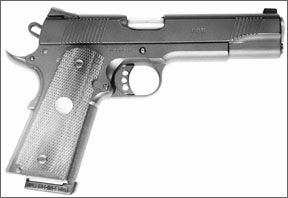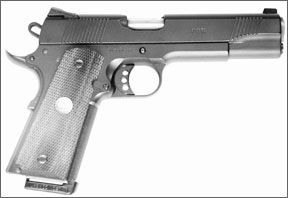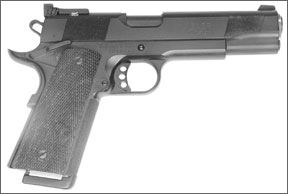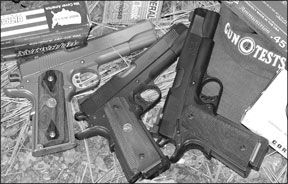If you have over two grand to put into a good 45 auto, which one will you get? For that kind of money you can pretty much tell a custom builder what you want and expect to get it, can’t you? Not quite, as it turns out. Or can you be satisfied with a fairly standard, if costly, over-the-counter 1911? We decided to take a look at some of the higher-priced 45s to see what gives. The test guns were full-size 1911s in 45 ACP caliber. We obtained a pistol called the Combat Custom ($2895 as tested) from a relatively new maker, Luke Volkmann of Volkmann Custom Inc., who will give you pretty much what you want for options, which we pitted against Wilson’s CQB ($2550) and Les Baer’s Premier II Super-Tac ($2280).

Attempting to pick the best one out of all these very fine handguns was anything but easy. They are all excellent, with fine triggers, great accuracy, and many touches that set them apart from the ordinary. In light of the ongoing national surge to buy all kinds of firearms, especially those designed for self defense, you may have a hard time finding one of these better-grade 1911s.
We shot the guns for accuracy and function, and evaluated them for self-defense training and general use. These were all outstanding pistols, yet we found some anomalies that might help you pick and choose. We tested with four types of ammunition, Black Hills’ hardball, Federal 185-grain Hi-Shok JHP, Cor-Bon 230-grain JHP, and with cast-lead, 230-grain round-nose Ultramax. We tested during a severe winter in Idaho, and thus had trouble achieving these guns’ full accuracy potential. Better conditions would have given better results, but the conditions were the same for all guns and thus valid for reference. They are hardly what you’d call lousy. Also, we shot two other known handguns every now and then during these tests to make sure we were not too far off base. Here is what we found.
Volkmann Custom, Inc., Combat Custom 45 ACP, $2895
This was the most eye-catching of the test guns because of its NP3 finish ($250 extra) and nicely checkered cocobolo grips. The gun comes in a sturdy range bag with three magazines. The Combat Custom featured well-done fine checkering on the straps, adjustable sights with tritium inserts ($50), an excellent trigger, and tight fitting that didn’t require a crowbar to rack the slide. The little touches included horizontal serrations on the back of the slide and along the top of the slide to cut glare, beveling on the front edges of the gun to prevent holster wear, and reasonable—but not complete—rounding of the gun’s upper surfaces to avoid cutting the hand during clearance drills. We really wish the makers of self-defensive 45 autos would all take a class at Thunder Ranch, or Front Sight, or Gunsite, or with Mas Ayoob or Chuck Taylor or Ken Hackathorn, and learn how to do a stovepipe-clearing drill. Only Bill Wilson has it right. Wilson has been a combat shooter long enough to make the tops of his guns cut-free. Of the other two makers here, Les Baer doesn’t have a clue, Volkmann knows what he’s doing but could do better.

Volkmann’s gun had $500 of options added to its basic price of $2395, the most important being $250 for its Robar Coating & Technologies NP3 finish, which we know and love. Note that Volkmann added only $300 for tritium sights and one of the finest non-corrosive finishes on the planet, while Baer (see below) adds $500 for similar extras.
We noted there were no forward serrations on the slide, which some won’t like. Oddly, that is not a custom option from Volkmann except on his Signature Series pistols, but we’d bet a nickel you can get it on any of his four models you want, if you’re willing to pay for it. The front of the gun had a well-fitted, thick barrel bushing with the company logo on the spring cap ($100). The barrel was made flush with this, which looked nice but also put extra tarnish from burned powder onto the bushing and logo cap.
The Volkmann had one of the better triggers of the group, actually the lightest at 3.5 pounds. On the range we got one jam with Cor-Bon’s fierce 230-grain JHP, but the gun laid ‘em all in there pretty well. In fact the overall accuracy of the Volkmann was very close to being the best for all ammo tested, but these were all very accurate handguns. We’d be nit-picking to try to declare which gun made the best groups. In our miserable winter test conditions every gun would make tiny clusters with all bullets touching with one or another type ammo, and then would land one outside that, which almost certainly was our fault. We really could not fault the Volkmann gun for any of its functions nor its appearance. It was well made, looked good, and would likely make its owner proud, if quite a bit lighter in the wallet.
Wilson Combat CQB 45 ACP, $2550
This is not our first association with Wilson’s CQB. We hope it’s not our last. These are very-well thought out, professionally made handguns produced by someone who really does know what he’s doing. They may not be the prettiest, nor the most accurate, but going into this test we knew we would be immensely surprised if the CQB failed to do exactly what it’s supposed to do. Long story short, we were not surprised.

This one was all black. We’ve seen and liked the two-tone versions, all of ‘em with Armor-Tuff finish, which is mighty durable but which will show slight wear over time. The finish was dead-flat dull, exactly what you want on a serious handgun. The sights were fixed, very hand-friendly, contoured for quick acquisition, gave an outstanding picture, and had tritium inserts. The gun shot to its sights perfectly with most of the test ammo.
The grip frame had fine checkering in front, slightly less-fine checkering on the mainspring housing, checkered grip panels of a black hue called Diamondwood, non-ambi safety, and a beveled mag well. New CQB’s come with a soft range bag and two magazines. You no longer get the fine ear muffs Wilson used to provide with every gun. You can customize your CQB somewhat as you order it, but for us, there’s precious little need to change anything about the basic CQB.
We believe the Wilson CQB is one of the standards by which all other combat 1911s can be judged. It does not have the slick features that distinguish some other handguns. There are no serrations at the back of the slide or along the slide to cut glare, but with its dull finish it hardly needs them. The gun’s price has risen steadily over the past few years, and that will keep them out of the hands of some. We believe they’re pretty good guns that have just about everything done exactly right. In fact our only complaint is their high cost, but all of these test guns are pretty costly, to put it mildly.
A very minor point of contention is the stainless barrel bushing. While the gun is slick on all its corners to avoid holster wear, the edges of the barrel bushing are razor-sharp. You can fix that yourself with a file and won’t need to reblue, because the bushing is stainless. Another point: the trigger is black coated, but was already showing wear on its side, which looks tacky. Why not just leave it white? The trigger pull was a crisp 3.8 pounds, which was just about perfect, we thought.
Les Baer Premiere II Super-Tac, $2280
Our test sample had fired enough rounds so we could work the slide normally, and this is the first Baer handgun we’ve handled that did that. Baer’s guns are usually so tightly fitted when new that a break-in is recommended before they can be considered ready to go.
Although the gun was lovely, shot well and handled fine, we found some slight problems. We thought that the rear sight was not deburred sufficiently. Its front corners would rip the hand when doing a stovepipe drill. The other problem we found was that the grip safety was nonfunctional. You could fire the gun without touching the grip safety. This was a loaner gun that may have been modified by its original owner, so this fault can’t be laid onto the manufacturer. We are aware some IPSC competitors used to pin the grip safety closed so the gun could always be fired, even if the shooter’s initial grasp was not quite perfect. If this were a new gun we would have to fail it, but because it’s used, we’ll only mention this as something to look out for. Ultimately, safety comes from the shooter, not the gun. And we understand it’s a simple fix to set this right.

We liked the left-side’s wide safety lever, but disliked the ambi portion which dug into our knuckle. The Baer felt really good in fast-action shooting, and we think that’s partly because of that wide safety. Our shooters like to rest the thumb on the safety while firing. The wood panels had the sharpest checkering of all three guns with wood grips. We noted the fully checkered grip panels on our test guns didn’t allow the shooting hand to get where it needed to be in the fastest manner. New wood checkering is sharp, and grabs the hand, and that on the Baer was very sharp. As wood checkering wears it gets better—faster—but a better choice, we thought, would be Kim Ahrends’ Tactical grips, with the rear portion uncheckered. Another reason we liked the Baer’s grip was because its mainspring housing was serrated, not checkered, and our grasping hand could slide upward just a bit as the hand closed onto the gun. All these things will change with different shooters, and what we liked you might hate. You might prefer smooth wood grips, or rubber, and some will like thinner panels. They’re easy to change.
The Baer had a trigger pull of 4.3 pounds, crisp and clean like all the others. We had one failure to feed with Cor-Bon 230-grain JHP, but the Baer kept on making tiny groups if we did our part. The more we shot it, the more we liked it. Yet as soon as we grabbed the slightly lighter CQB, all thoughts of the Baer went out the window. We suspect it was the slight annoyance of the ambi safety digging into our finger with the Baer, but not with the Wilson. And there were subtle balance differences too, which defies description. The Baer was 1.4 ounces heavier than the Wilson, and that little bit becomes very apparent when comparing these guns against each other. Bottom line, the Baer needed just a touch of work to please us, and that would damage some of the fine finish.
We can buy a reduced-price Les Baer—and we would—but we can’t buy a less-costly Wilson CQB or Volkmann. As tested, the Baer was the least costly, but it didn’t please some of our shooters because of the painful ambi safety and the hand-cutting rear sight. While it might produce smaller groups than the slightly handier Wilson, that’s not necessary in a fighting handgun, nor are adjustable sights. What you want is 100-percent perfect function, comfort, and simplicity. The Wilson has all those features, and though it cost more than the Baer it didn’t need anything done to it.
The Volkmann had the best trigger, the most weight, and accuracy as good as the Baer, but it had a cost that we could not quite justify. While some of us can live without forward serrations, most want them, and they’d add more to the Volkmann’s already high cost. We’d buy the Volkmann only if we could not get a Wilson CQB or a Les Baer. We’d buy the Wilson CQB first, the Baer second, and this Volkmann, as tested, a distant third. If we were pressed for cash we’d go with the excellent, lower-priced Les Baer Premier II.






























